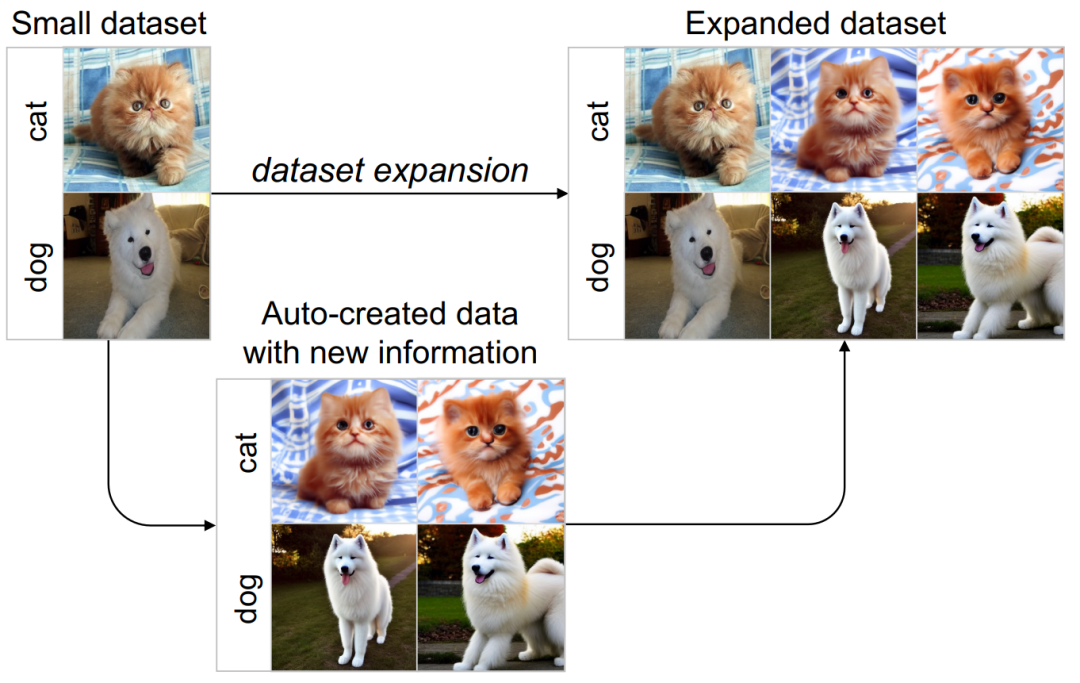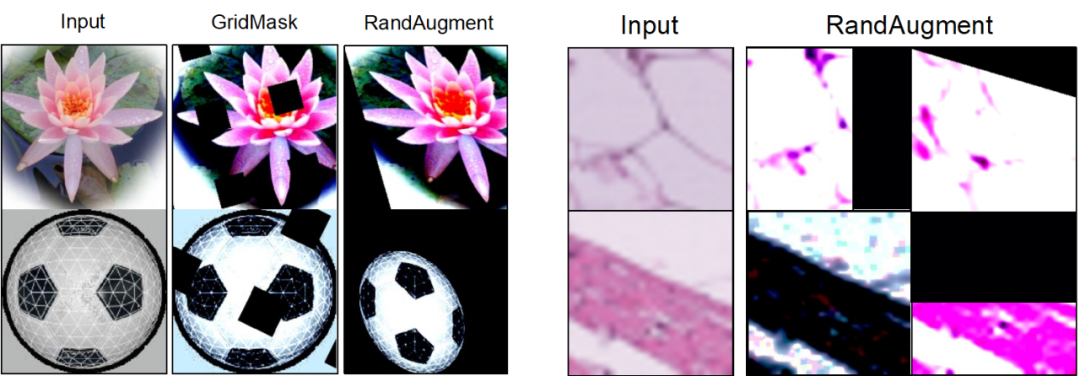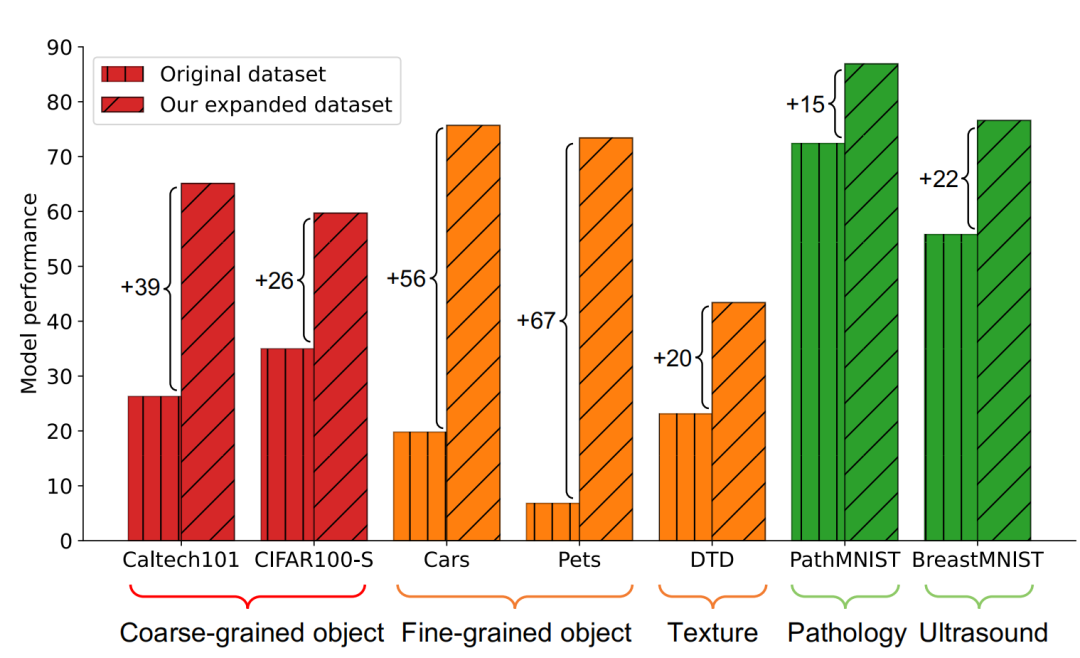 Technology peripherals
Technology peripherals
 AI
AI
 Introducing a new GIF framework: Following the example of humans, a new paradigm for data set amplification has arrived
Introducing a new GIF framework: Following the example of humans, a new paradigm for data set amplification has arrived
Introducing a new GIF framework: Following the example of humans, a new paradigm for data set amplification has arrived

- ## Paper link: https://browse.arxiv.org/pdf/2211.13976.pdf
- GitHub: https://github.com/Vanint/DatasetExpansion
As we all know, the performance of deep neural networks depends heavily on training data The quantity and quality make it difficult for deep learning to be widely applied to small data tasks. For example, in small data application scenarios in medical and other fields, manually collecting and labeling large-scale data sets is often time-consuming and laborious. To address this data scarcity problem and minimize data collection costs, this paper explores a new paradigm of data set augmentation, which aims to automatically generate new data to expand the small data set of the target task into a larger and more informative one. Big data sets. These augmented datasets are dedicated to improving the performance and generalization capabilities of the model and can be used to train different network structures

This work It was found that simply using existing methods cannot expand the data set well. (1) Random data enhancement mainly changes the surface visual characteristics of the picture, but cannot create pictures with new object content (the lotus in the picture below is still the same, no new lotus is generated), so the amount of information introduced is limited. What's more serious is that random data enhancement may crop the lesion (change) position of the medical image, resulting in the reduction of important information of the sample and even the generation of noisy data. (2) Directly using pre-trained generative (diffusion) models for data set amplification cannot well improve the performance of the model on the target task. This is because the pre-training data of these generative models often have large distribution differences with the target data, which results in a certain distribution and category gap between the data they generate and the target task, and it is impossible to ensure that the generated samples have the correct category. labels and useful for model training.

#To achieve more efficient data set augmentation, researchers have explored human associative learning. When humans have prior knowledge of an object, they can easily imagine different variations of the object, such as variations of the dog in different types, colors, shapes, or backgrounds in the picture below. This process of imaginative learning is very instructive for dataset amplification because it goes beyond simply perturbing the appearance of the animals in the picture, but applies rich prior knowledge to create variant pictures with new information.

#However, we cannot directly model humans as a priori models for data imagination. Fortunately, recent generative models (such as Stable Diffusion, DALL-E2) have demonstrated a powerful ability to fit the distribution of large-scale data sets, and can generate rich and realistic images. This inspired this paper to use pre-trained generative models as prior models, leveraging their strong prior knowledge to perform efficient data association and amplification on small data sets.

Based on the above ideas, this work proposes a new Guided Imagination Framework (GIF). This method can effectively improve the classification performance and generalization ability of deep neural networks on natural and medical image tasks, and greatly reduce the huge costs caused by manual data collection and annotation. At the same time, the expanded data set also helps promote transfer learning of the model and alleviate the long-tail problem.

Next let’s see how this new paradigm of data set amplification is designed.
Method
Challenges and guiding standards for data set amplification There are two methods for designing data set amplification. Key challenges: (1) How to make the generated samples have the correct category labels? (2) How to ensure that the generated samples contain new information to promote model training? To address these two challenges, this work discovered two amplification guiding criteria through extensive experiments: (1) category-consistent information enhancement; (2) sample diversity improvement.

Methodological Framework Based on the discovered amplification guiding criteria, this work proposes guided imagination Amplified frame (GIF). For each input seed sample x, GIF first uses the feature extractor of the prior generative model to extract the sample feature f, and performs noise perturbation on the feature:  . The simplest way to set the noise (z, b) is to use Gaussian random noise, but it cannot ensure that the generated samples have the correct class label and brings more information. Therefore, for efficient dataset amplification, GIF optimizes noise perturbations based on its discovered amplification guideline, i.e.
. The simplest way to set the noise (z, b) is to use Gaussian random noise, but it cannot ensure that the generated samples have the correct class label and brings more information. Therefore, for efficient dataset amplification, GIF optimizes noise perturbations based on its discovered amplification guideline, i.e.  .
.

The amplification guidance standards used are implemented as follows. Class-consistent information quantity index:  ; sample diversity index:
; sample diversity index: 
 . By maximizing these two indicators, GIF can effectively optimize noise perturbation, thereby generating samples that maintain category consistency and bring greater information content.
. By maximizing these two indicators, GIF can effectively optimize noise perturbation, thereby generating samples that maintain category consistency and bring greater information content.
Experiment
Amplification effectiveness GIF has stronger amplification effectiveness : GIF-SD improves the classification accuracy by an average of 36.9% on 6 natural datasets, and improves the classification accuracy by an average of 13.5% on 3 medical datasets.

Amplification efficiency GIF has stronger amplification efficiency: in Cars and DTD On the data set, the effect of using GIF-SD for 5-fold amplification even exceeds the effect of using random data augmentation for 20-fold amplification.

Visualization results Existing data augmentation methods cannot generate new image content, and GIF Can better generate samples with new content.

Existing enhancement methods may cut the location of lesions in medical images, resulting in reduced sample information and noise, while GIF can be better preserved Their category semantics

Computation and time cost Compared with manual data collection and annotation, GIFs can significantly reduce the time and cost of data set augmentation.

Versatility of amplified data Once amplified, these data sets can be directly used to train a variety of different Neural network model structure.

Improve model generalization ability GIF helps to improve the model’s out-of-distribution generalization performance (OOD generalization).

Alleviate the long tail problem GIF helps alleviate the long tail problem.

Safety Check The images generated by GIF are safe and harmless.

Based on the above experimental results, we have reason to believe that by simulating human analogy and imagination learning, the method designed in this paper can effectively amplify Small data sets, thereby improving the implementation and application of deep neural networks in small data task scenarios.
The above is the detailed content of Introducing a new GIF framework: Following the example of humans, a new paradigm for data set amplification has arrived. For more information, please follow other related articles on the PHP Chinese website!

Hot AI Tools

Undresser.AI Undress
AI-powered app for creating realistic nude photos

AI Clothes Remover
Online AI tool for removing clothes from photos.

Undress AI Tool
Undress images for free

Clothoff.io
AI clothes remover

AI Hentai Generator
Generate AI Hentai for free.

Hot Article

Hot Tools

Notepad++7.3.1
Easy-to-use and free code editor

SublimeText3 Chinese version
Chinese version, very easy to use

Zend Studio 13.0.1
Powerful PHP integrated development environment

Dreamweaver CS6
Visual web development tools

SublimeText3 Mac version
God-level code editing software (SublimeText3)

Hot Topics
 1382
1382
 52
52
 Open source! Beyond ZoeDepth! DepthFM: Fast and accurate monocular depth estimation!
Apr 03, 2024 pm 12:04 PM
Open source! Beyond ZoeDepth! DepthFM: Fast and accurate monocular depth estimation!
Apr 03, 2024 pm 12:04 PM
0.What does this article do? We propose DepthFM: a versatile and fast state-of-the-art generative monocular depth estimation model. In addition to traditional depth estimation tasks, DepthFM also demonstrates state-of-the-art capabilities in downstream tasks such as depth inpainting. DepthFM is efficient and can synthesize depth maps within a few inference steps. Let’s read about this work together ~ 1. Paper information title: DepthFM: FastMonocularDepthEstimationwithFlowMatching Author: MingGui, JohannesS.Fischer, UlrichPrestel, PingchuanMa, Dmytr
 The world's most powerful open source MoE model is here, with Chinese capabilities comparable to GPT-4, and the price is only nearly one percent of GPT-4-Turbo
May 07, 2024 pm 04:13 PM
The world's most powerful open source MoE model is here, with Chinese capabilities comparable to GPT-4, and the price is only nearly one percent of GPT-4-Turbo
May 07, 2024 pm 04:13 PM
Imagine an artificial intelligence model that not only has the ability to surpass traditional computing, but also achieves more efficient performance at a lower cost. This is not science fiction, DeepSeek-V2[1], the world’s most powerful open source MoE model is here. DeepSeek-V2 is a powerful mixture of experts (MoE) language model with the characteristics of economical training and efficient inference. It consists of 236B parameters, 21B of which are used to activate each marker. Compared with DeepSeek67B, DeepSeek-V2 has stronger performance, while saving 42.5% of training costs, reducing KV cache by 93.3%, and increasing the maximum generation throughput to 5.76 times. DeepSeek is a company exploring general artificial intelligence
 AI subverts mathematical research! Fields Medal winner and Chinese-American mathematician led 11 top-ranked papers | Liked by Terence Tao
Apr 09, 2024 am 11:52 AM
AI subverts mathematical research! Fields Medal winner and Chinese-American mathematician led 11 top-ranked papers | Liked by Terence Tao
Apr 09, 2024 am 11:52 AM
AI is indeed changing mathematics. Recently, Tao Zhexuan, who has been paying close attention to this issue, forwarded the latest issue of "Bulletin of the American Mathematical Society" (Bulletin of the American Mathematical Society). Focusing on the topic "Will machines change mathematics?", many mathematicians expressed their opinions. The whole process was full of sparks, hardcore and exciting. The author has a strong lineup, including Fields Medal winner Akshay Venkatesh, Chinese mathematician Zheng Lejun, NYU computer scientist Ernest Davis and many other well-known scholars in the industry. The world of AI has changed dramatically. You know, many of these articles were submitted a year ago.
 Hello, electric Atlas! Boston Dynamics robot comes back to life, 180-degree weird moves scare Musk
Apr 18, 2024 pm 07:58 PM
Hello, electric Atlas! Boston Dynamics robot comes back to life, 180-degree weird moves scare Musk
Apr 18, 2024 pm 07:58 PM
Boston Dynamics Atlas officially enters the era of electric robots! Yesterday, the hydraulic Atlas just "tearfully" withdrew from the stage of history. Today, Boston Dynamics announced that the electric Atlas is on the job. It seems that in the field of commercial humanoid robots, Boston Dynamics is determined to compete with Tesla. After the new video was released, it had already been viewed by more than one million people in just ten hours. The old people leave and new roles appear. This is a historical necessity. There is no doubt that this year is the explosive year of humanoid robots. Netizens commented: The advancement of robots has made this year's opening ceremony look like a human, and the degree of freedom is far greater than that of humans. But is this really not a horror movie? At the beginning of the video, Atlas is lying calmly on the ground, seemingly on his back. What follows is jaw-dropping
 KAN, which replaces MLP, has been extended to convolution by open source projects
Jun 01, 2024 pm 10:03 PM
KAN, which replaces MLP, has been extended to convolution by open source projects
Jun 01, 2024 pm 10:03 PM
Earlier this month, researchers from MIT and other institutions proposed a very promising alternative to MLP - KAN. KAN outperforms MLP in terms of accuracy and interpretability. And it can outperform MLP running with a larger number of parameters with a very small number of parameters. For example, the authors stated that they used KAN to reproduce DeepMind's results with a smaller network and a higher degree of automation. Specifically, DeepMind's MLP has about 300,000 parameters, while KAN only has about 200 parameters. KAN has a strong mathematical foundation like MLP. MLP is based on the universal approximation theorem, while KAN is based on the Kolmogorov-Arnold representation theorem. As shown in the figure below, KAN has
 The vitality of super intelligence awakens! But with the arrival of self-updating AI, mothers no longer have to worry about data bottlenecks
Apr 29, 2024 pm 06:55 PM
The vitality of super intelligence awakens! But with the arrival of self-updating AI, mothers no longer have to worry about data bottlenecks
Apr 29, 2024 pm 06:55 PM
I cry to death. The world is madly building big models. The data on the Internet is not enough. It is not enough at all. The training model looks like "The Hunger Games", and AI researchers around the world are worrying about how to feed these data voracious eaters. This problem is particularly prominent in multi-modal tasks. At a time when nothing could be done, a start-up team from the Department of Renmin University of China used its own new model to become the first in China to make "model-generated data feed itself" a reality. Moreover, it is a two-pronged approach on the understanding side and the generation side. Both sides can generate high-quality, multi-modal new data and provide data feedback to the model itself. What is a model? Awaker 1.0, a large multi-modal model that just appeared on the Zhongguancun Forum. Who is the team? Sophon engine. Founded by Gao Yizhao, a doctoral student at Renmin University’s Hillhouse School of Artificial Intelligence.
 Kuaishou version of Sora 'Ke Ling' is open for testing: generates over 120s video, understands physics better, and can accurately model complex movements
Jun 11, 2024 am 09:51 AM
Kuaishou version of Sora 'Ke Ling' is open for testing: generates over 120s video, understands physics better, and can accurately model complex movements
Jun 11, 2024 am 09:51 AM
What? Is Zootopia brought into reality by domestic AI? Exposed together with the video is a new large-scale domestic video generation model called "Keling". Sora uses a similar technical route and combines a number of self-developed technological innovations to produce videos that not only have large and reasonable movements, but also simulate the characteristics of the physical world and have strong conceptual combination capabilities and imagination. According to the data, Keling supports the generation of ultra-long videos of up to 2 minutes at 30fps, with resolutions up to 1080p, and supports multiple aspect ratios. Another important point is that Keling is not a demo or video result demonstration released by the laboratory, but a product-level application launched by Kuaishou, a leading player in the short video field. Moreover, the main focus is to be pragmatic, not to write blank checks, and to go online as soon as it is released. The large model of Ke Ling is already available in Kuaiying.
 Tesla robots work in factories, Musk: The degree of freedom of hands will reach 22 this year!
May 06, 2024 pm 04:13 PM
Tesla robots work in factories, Musk: The degree of freedom of hands will reach 22 this year!
May 06, 2024 pm 04:13 PM
The latest video of Tesla's robot Optimus is released, and it can already work in the factory. At normal speed, it sorts batteries (Tesla's 4680 batteries) like this: The official also released what it looks like at 20x speed - on a small "workstation", picking and picking and picking: This time it is released One of the highlights of the video is that Optimus completes this work in the factory, completely autonomously, without human intervention throughout the process. And from the perspective of Optimus, it can also pick up and place the crooked battery, focusing on automatic error correction: Regarding Optimus's hand, NVIDIA scientist Jim Fan gave a high evaluation: Optimus's hand is the world's five-fingered robot. One of the most dexterous. Its hands are not only tactile



